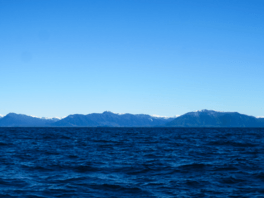Chatham Sound facts for kids
Quick facts for kids Chatham Sound |
|
|---|---|
| French: Bassin de Chatham | |

Looking Northeasterly across Chatham Sound
|
|
| Location | British Columbia, Canada, between Dundas Islands, Stephens Islands and Tsimpsean Peninsula |
| Coordinates | 54°22′30″N 130°35′30″W / 54.37500°N 130.59167°W |
| Primary inflows | Nass River, Skeena River |
| Primary outflows | Dixon Entrance, Hecate Strait |
| Surface area | 1,600 square kilometres (600 sq mi) |
Chatham Sound is a large body of water located on the northern coast of British Columbia, Canada. It's right next to Alaska, United States. This sound is found between the Dundas and Stephens Islands and the Tsimpsean Peninsula. It is very close to the city of Prince Rupert.
Chatham Sound is part of the Inside Passage. This is a famous water route that stretches along the coast. The sound goes from Portland Inlet in the north down to Porcher Island in the south. It was likely named in 1788 by a British captain named Charles Duncan. He probably named it after John Pitt, 2nd Earl of Chatham. John Pitt was an important leader in the British Navy at that time.
Geography of Chatham Sound
Chatham Sound is like a big, partly closed-off bay. It covers an area of about 1,550 square kilometers (600 square miles). It connects to the wider ocean through several channels. These channels include Main, Brown, Hudson Bay, and Edye Passages. They lead out to the Hecate Strait and Dixon Entrance.
At its southern end, Chatham Sound also connects to other inland waterways. These include the Marcus and Arthur Passages. Beyond those, you can reach the Grenville Channel.
Two major rivers flow into Chatham Sound. The Nass River enters through the Portland Inlet. The Skeena River flows in through the Inverness and Marcus Passages. Because so much fresh water from these rivers flows in, the water in Chatham Sound is less salty than the open ocean nearby.
Water Conditions in Chatham Sound
Most of Chatham Sound is less than 180 meters (100 fathoms) deep. However, in the northern part of the sound, the water gets much deeper. Some areas there are more than 550 meters (300 fathoms) deep.
Chatham Sound experiences very large tides. The water level can change by as much as 7.7 meters (25 feet). On average, the tide changes by about 4.9 meters (16 feet). Because of these big tides, the currents in the sound are very strong. This is especially true in the southern and western parts of the area.
Amazing Ocean Life
The strong tides in Chatham Sound help mix the water. This mixing creates a perfect environment for tiny ocean plants called phytoplankton to grow. These tiny plants are the base of the food chain. This means Chatham Sound is a very productive area for marine life.
The sound is home to many different kinds of shrimp. It has the most types of shrimp in the entire Pacific North Coast Integrated Management Area. The most common type is the humpback shrimp. You can also find large groups of Dungeness crab living in the area.
Scientists once thought that certain types of sponge reefs were extinct. But now, we know they are a very important part of the seafloor in Chatham Sound. The biggest group of these reefs is now called the Chatham Sound Reef Complex. These reefs are like underwater cities for many ocean creatures.


